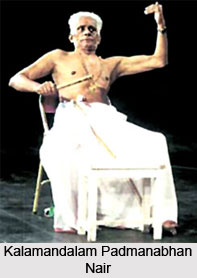 Kalamandalam Padmanabhan Nair was a performer, teacher, and scholar of the Kalluvazhi school of Kathakali. He was born in Kuruvattoor village near Cherpalcheri in Palakkad district in 1928. Kalamandalam Padmanabhan Nair was the son of the legendary Pattikkantodi Ramunni Menon. After his primary education, he became his father`s disciple at the Vellinezhi Kalari. Nair debuted as Krishna in Subhadrahamnam or `Subhadra`s Abduction`. In 1939, he joined the Kerala Kalamandalam with his father, continuing to train under him there and at P. S. V. Natyasangham, Kottakkal in Malappuram district. There Kalamandalam Padmanabhan Nair became Kathakali instructor after his father`s death in 1948. In 1951, the poet Vallathol Menon appointed him to teach at the Kalamandalam. Their friendship helped him gain an authentic knowledge of the literature, theory, and practice of Kathakali. Kalamandalam Padmanabhan Nair stayed with the Kalamandalam, retiring as principal in 1989.
Kalamandalam Padmanabhan Nair was a performer, teacher, and scholar of the Kalluvazhi school of Kathakali. He was born in Kuruvattoor village near Cherpalcheri in Palakkad district in 1928. Kalamandalam Padmanabhan Nair was the son of the legendary Pattikkantodi Ramunni Menon. After his primary education, he became his father`s disciple at the Vellinezhi Kalari. Nair debuted as Krishna in Subhadrahamnam or `Subhadra`s Abduction`. In 1939, he joined the Kerala Kalamandalam with his father, continuing to train under him there and at P. S. V. Natyasangham, Kottakkal in Malappuram district. There Kalamandalam Padmanabhan Nair became Kathakali instructor after his father`s death in 1948. In 1951, the poet Vallathol Menon appointed him to teach at the Kalamandalam. Their friendship helped him gain an authentic knowledge of the literature, theory, and practice of Kathakali. Kalamandalam Padmanabhan Nair stayed with the Kalamandalam, retiring as principal in 1989.
Kalamandalam Padmanabhan Nair was a great scholar. Although he acts the most technically demanding paccha heroes and katti antagonists, Brahmans, sages, the swan, the primitive hunter, and, rarely, the evil Bali and Dussasana, Kalamandalam Padmanabhan Nair particularly likes to perform sattvika or pure roles. As a preceptor, he stresses strict discipline and specializes in grammar. Kalamandalam Padmanabhan Nair believes that the eyes are important instruments for a Kathakali actor because they communicate the fullest nature of the character. Thus eye exercises form a major subject in his Kalari. Kalamandalam Padmanabhan Nair follows his father`s footsteps in explaining minutely to his students, who include Kalamandalam Gopi, his first disciple. Kalamandalam Padmanabhan Nair wrote a textbook, Kathakali vesham or `Kathakali Characters`, and attaprakaras or acting manuals for sixteen plays. As a member of the Kalamandalam troupe he toured widely abroad. Kalamandalam Padmanabhan Nair died on 3rd April 2007.




















